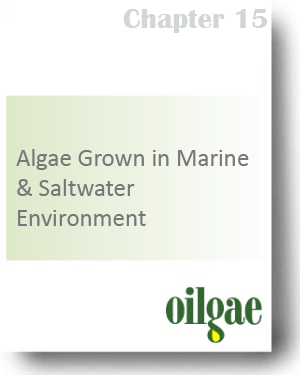Chapter XV - Algae Grown in Marine & Saltwater Environment
This page provides details of the chapter XV, from the Comprehensive Oilgae Report. You can purchase this chapter alone using the payment button provided below.
Introduction
Marine algae, or seaweeds, are the oldest members of the plant kingdom, extending back many hundreds of millions of years. Marine algae are mostly found in shallow ocean water near rocky shores. They are also found in fresh water, such as ponds, lakes, and rivers. They have little tissue differentiation, no true vascular tissue, no roots, stems, or leaves, and no flowers.
Various marine algae species and their cultivation methods are discussed in this chapter. Cultivating seaweed has been done for a long time in Japan and other parts of Asia for the purpose of food. There are many different ways to cultivate macroalgae. They can be cultivated by simply tying them to anchored floating lines. Seaweeds do not require soil for their cultivation which is one of the major advantages when compared to other crops which compete for land.
List of Contents
- Introduction
- Algae Strains that Grow Well in Marine or Saltwater Environment
- Prominent Companies Growing Algae in Saltwater
- Cultivating Algae in Marine Environments – Companies & Updates
- Marine Algae Cultivation – Q&A
- Research
- References
List of Tables
- Composition of Seawater
- Detailed Composition of Seawater at 3.5% Salinity
Key Takeaways from the chapter
- Both macroalgae (seaweeds) and microalgae can be cultivated in marine environments for fuel, but macroalgae are expected to be more suitable for this environment.
- Wild seaweeds grown in marine environments provide a good opportunity to make low cost ethanol.
- Less than 3% of the world's oceans would be needed to fully substitute for fossil fuels, but cultivating and harvesting algae in open oceans might be more difficult than it appears at first thought.
- Some scale versions of marine-based algae cultivation for fuel have started. For instance, in September 2008, South Korea's government signed a deal to lease 25,000 hectares (61,750 acres or about 90 square miles) of Indonesian coastal waters to grow seaweed for bioethanol fuel.
- Algae are already being cultivated in ocean for non-fuel purposes such as cosmetics, medicines and phycocollids.
- Few efforts have been successful in the cultivation of oil bearing microalgae in marine environments; however, there have been relatively greater success in cultivating them in non-oceanic salt water environments.
We are no more selling this report. |
|
No of Pages : 14 Last Updated : Dec 2011 Price : 25 US $ |
Related Chapters from the Section III – Processes & Challenges

